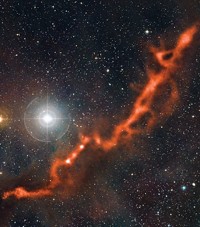Advertisement
Grab your lab coat. Let's get started
Welcome!
Welcome!
Create an account below to get 6 C&EN articles per month, receive newsletters and more - all free.
It seems this is your first time logging in online. Please enter the following information to continue.
As an ACS member you automatically get access to this site. All we need is few more details to create your reading experience.
Not you? Sign in with a different account.
Not you? Sign in with a different account.
ERROR 1
ERROR 1
ERROR 2
ERROR 2
ERROR 2
ERROR 2
ERROR 2
Password and Confirm password must match.
If you have an ACS member number, please enter it here so we can link this account to your membership. (optional)
ERROR 2
ACS values your privacy. By submitting your information, you are gaining access to C&EN and subscribing to our weekly newsletter. We use the information you provide to make your reading experience better, and we will never sell your data to third party members.
Astrochemistry
The end has come for the iconic Arecibo telescope
Astrochemists lament lost research possibilities
by Sam Lemonick
November 23, 2020

The National Science Foundation announced last week that it will dismantle the famed Arecibo radio telescope, after broken cables put the structure’s stability in doubt. While best known for planetary research and searching for extraterrestrial life, Arecibo was used to discover some prebiotic molecules—and astrochemists had expected it to play a role in future searches for heavy molecules in space.
Built in the early 1960s to study the Earth’s ionosphere, the Arecibo Observatory’s 305 m radio dish was the largest in the world until 2015. Upgrades through the years made it a useful platform for studying our solar system, as well as stars and other objects beyond it. Built into a natural depression in the Puerto Rican jungle, the telescope made appearances in movies like Contact—a fictionalization of real extraterrestrial intelligence research at the site—and the James Bond film GoldenEye.
In August a cable supporting the telescope’s hanging instrument platform snapped, possibly as a result of hurricanes and earthquakes over the last several years. Repairs were planned, but when a second cable broke on November 7, engineers decided the remaining cables might be weaker than estimated and determined that it was not practicable to carry out safe repairs. The NSF, Arecibo’s main funder, decided to dismantle the telescope to allow other research activities at the facility to continue.
Arecibo played an important role in several astrochemistry discoveries. In 2008, observatory researchers announced they had detected the amino acid precursors methanimine and hydrogen cyanide in a galaxy 250 million light years from Earth (Astron. J. 2008, DOI: 10.1088/0004-6256/136/1/389). More recently, astronomers used the telescope to identify methanol and hydroxyl signatures in star-forming regions of space (Mon. Not. R. Astron. Soc. 2020, DOI: 10.1093/mnras/staa1841).
Brett McGuire, an astrochemist at Massachusetts Institute of Technology, says chemists looking for small molecules in space have focused their searches on regions of the electromagnetic spectrum outside what Arecibo could observe. But he and others point out that larger molecules often have bright signatures right in Arecibo’s range. McGuire says he and his group talked this week about using Arecibo for future observations. “It may have been an ideal instrument for probing many of these exciting new species,” he says.
Some research may now be impossible without Arecibo, according to astrophysicist Esteban D. Araya of Western Illinois University. Araya was part of a project hoping to use CH signatures to trace filaments of potential star-forming material that stretch across the interstellar medium. Araya says other telescopes lack the resolution and sensitivity to make the necessary observations.




Join the conversation
Contact the reporter
Submit a Letter to the Editor for publication
Engage with us on Twitter